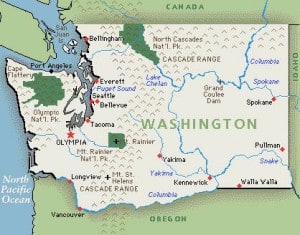Washington State is one of the four remaining monopolistic states (where the state government is the insurer rather than private insurance companies). In the November 2, 2010 election, there was a measure on the state ballot to privatize Washington’s workers compensation system, but it was rejected by the voters.
Compulsory Coverage
Employers with one or more employees must have workers compensation insurance for the employee(s). Sole providers, partners, corporate officers, and the manager of a limited liability company may elect to exclude themselves from the workers compensation insurance coverage requirements. Workers compensation coverage is not required for a newspaper carrier, a beautician or barber renting booth space, a child under age of 18 employed on the family farm, a domestic or gardener for a private home as long as only one person is employed, and a person working for a religious or charitable organization in exchange for sustenance.
Obtaining Coverage
To obtain workers compensation coverage in Washington, the employer has two options which are:
- Participate in the state monopolistic workers compensation insurance program administered by the Washington State Fund in the Department of Labor & Industries.
- Meet standards set by Washington State to be a self-insured employer. (About 400 employers in Washington are self-insured, but they are the largest employers covering between one-fourth and one-third of the total workforce.)
Click Link to Access Free PDF Download
Claim Reporting
The employee must submit to Department of Labor & Industries or the self-insured employer a claim application within one year of the injury or within two years of the doctor’s diagnosis of an occupational disease. The medical providers of employees covered through the State Fund are required to submit the Report of Industrial Injury or Occupational Disease. The medical providers to employees of employers who are self-insured are required to submit to the employer the Self Insurer Accident Report. If the employee is unable to return to work, the physician is required to submit the Activity Prescription Form.
Cost of Workers Compensation
Washington is the only state that allows the employers (who purchase workers compensation insurance from the State Fund) to deduct a part of the cost of workers compensation from the employees’ wages. The employer can deduct up to half of the cost of the premium portion that pays the medical benefits and the portion of the premium that pays the cost of living increases for the injured workers drawing life-time compensation benefits – known as pensions. Employers must pay the entire portion of the premium that is used to pay lost time compensation and pensions. Overall, employees pay approximately 27 percent of the total work comp premium to the state.
Self-insured employers can deduct from the employees wages: 1) one-half of the Supplemental Pension Fund assessment; 2) one-half of the Asbestos Fund assessment; 3) the self-insurance Overpayment Reimbursement Assessment.
Medical Benefits
The employee selects the medical provider of their choice. If the employee is not satisfied with the medical care provided, the employee can change doctors at will. If the employee is not satisfied with the medical recommendations of the selected medical provider, a second opinion can be obtained if approved by the claims administrator.
All reasonable and necessary medical care is covered by workers compensation. There are no time limitations or monetary limitations on the medical benefits. All billing of medical services by medical providers must be in compliance with the fee schedules published each year by the State Fund.
Temporary Total Disability (TTD)
When an employee in Washington State is certified by the medical provider as unable to return to work, the State Fund or the self-insured employer will pay TTD. The compensation rate varies from 60% to 75% of the gross wages, depending on the employees martial status (or registered domestic partnership) and how many dependents the employee has (60% for the employee, 5% additional for a spouse, and 2% additional for each additional dependent, up to 5 additional dependents).
The maximum amount of TTD benefits that can be paid is 120 percent of the state average monthly wage. The minimum amount of loss time compensation benefits that can be paid is 15 percent of the state average monthly wage. The maximum amount had been recalculated each year, with the new rate going into effect on July 1st. On June 5, 2011 a one-year freeze on time loss benefits was signed into law. The TTD benefit maximum for July 1, 2011, through June 30, 2012, will be the same as the previous year. The monthly dollar maximum TTD benefit for July 1, 2011, through June 30, 2012, is $4,715 and the monthly minimum TTD benefit is $185.
The first 3 days of disability (the waiting period) are not paid to the injured employee unless the employee is disabled for more than 14 days. TTD benefits can be paid for as long as the medical provider keeps the employee off work.
The Stay-at-Work Program instituted by the Labor & Industries office effective June 15, 2011 is taking a very proactive approach to providing modified duty to injured employees. In the new program the Labor and Industries office will reimburse employers for half of the worker’s wages while the employee is on working on modified duty. The Stay-at-Work Program is designed to speed workers’ recovery, prevent long-term disability, and reduce cost for both the State of Washington and for the employer.
Permanent Partial Disability Benefits
Washington State employees are paid permanent partial disability (PPD) benefits for any permanent disability suffered as the result of an on-the-job injury. Washington State uses a schedule of injuries for limbs, vision and hearing. The total loss of a body part is worth a set dollar amount stated in the schedule. A partial loss is paid as a percentage of the set dollar amount.
For non-scheduled injuries, the maximum period of payments is not specified. The maximum dollar amount for permanent partial disability is currently (February, 2011) $149,116 but subject to change each July 1st. Payments are based on a percentage of disability.
Permanent Total Disability (PTD)
The amount of indemnity compensation for PTD is calculated the same as for TTD. PTD is paid for the balance of the employee’s life, but the State Fund or the self-insured employer is allowed an offset for the amount of Social Security benefits the employee receives. PTD benefits are referred to as pension. The injured employees drawing a pension also get an annual cost of living increase. There is no provision in the state workers comp law for a settlement of PTD claims. Therefore, the Washington State Fund has a funding problem now with half of all workers comp payments going to people drawing lifetime pensions.
In an effort to reduce the amount of money being paid for PTD, effective June 15, 2011, workers who are age 55 or older have the option to negotiate a settlement agreement with periodic payments rather than staying in the work comp system or being retrained for another job. The workers who opt for the settlement agreement will continue to be eligible for medical care.
FREE DOWNLOAD: “Step-By-Step Process To Master Workers’ Comp In 90 Days”
Death Benefits
The burial expenses in Washington State are covered for a work-related death up to $7,709.32. The death benefits for a dependent spouse are 60% of the average monthly wage plus 2% for each dependent child up to 5 children. The maximum and minimum amounts follow the TTD guidelines. There is no lifetime maximum amount or dollar maximum for death benefits. If the spouse remarries, the spouse receives 24 months of death benefits or the lifetime annuity value, if less. Children receive benefits until age 18 or until age 23 if a full-time student. Disabled children can receive death benefits beyond the age of 18.
Vocational Benefits
Washington workers compensation law also includes discretionary vocational benefits (the State Fund or the self-insured employer determines whether or not they will offer vocational benefits). Vocational rehabilitation is in the best interest of the employer and the employee as placement in a new job reduces or eliminates the amount of PPD that will be paid, and stops the employee from making a claim for a lifetime pension (PTD).
If the injured employee is unable to return to their prior job due to disabilities from the on-the-job injury, and the employee does not have the skills for a different job, a vocational counselor can be assigned to work with the employee. If the employee declines the vocational counseling, medical and indemnity benefits can be terminated. The vocational counselor will develop a training plan that is reviewed and approved by the Department of Labor & Industries. The vocational plan includes a job goal based on the employee’s skills, interest and medically documented limitations. It can include schooling or on-the-job training for up two years.
Workers Compensation Laws change frequently. This is only a summary; a complete copy of the most up-to-date version can be found at: www.WorkCompResearch.com an excellent service. http://workcompresearch.com/
Author Rebecca Shafer, JD, President of Amaxx Risks Solutions, Inc. is a national expert in the field of workers compensation. She is a writer, speaker, and website publisher. Her expertise is working with employers to reduce workers compensation costs, and her clients include airlines, healthcare, printing/publishing, pharmaceuticals, retail, hospitality, and manufacturing. See www.LowerWC.com for more information. Contact:RShafer@ReduceYourWorkersComp.com or 860-553-6604.
WORK COMP CALCULATOR: http://www.LowerWC.com/calculator.php
MODIFIED DUTY CALCULATOR: http://www.LowerWC.com/transitional-duty-cost-calculator.php
WC GROUP: http://www.linkedin.com/groups?homeNewMember=&gid=1922050/
SUBSCRIBE: Workers Comp Resource Center Newsletter
Do not use this information without independent verification. All state laws vary. You should consult with your insurance broker or agent about workers comp issues.
©2011 Amaxx Risk Solutions, Inc. All rights reserved under International Copyright Law. If you would like permission to reprint this material, contact Info@ReduceYourWorkersComp.com
FREE DOWNLOAD: “Step-By-Step Process To Master Workers’ Comp In 90 Days”








